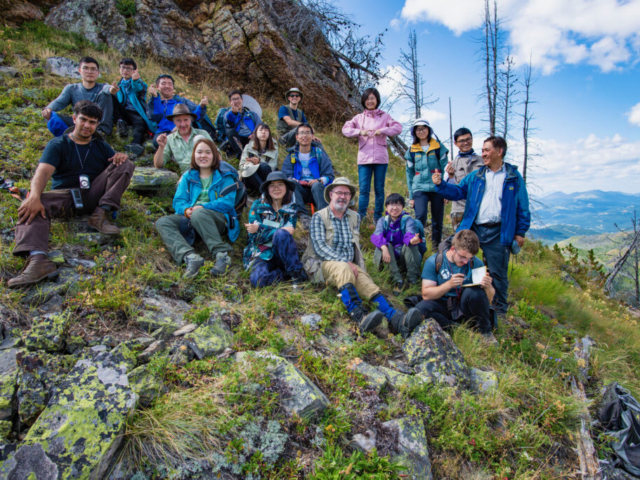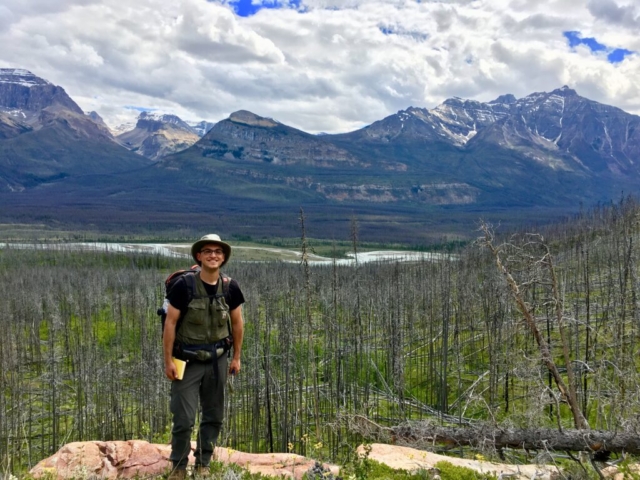Scott Melnyk
Research in Sedimentology and Ichnology
About

I completed my PhD in 2023 with the Ichnology Research Group at the University of Alberta, studying under the guidance of Dr. Murray Gingras. My PhD focused on animal-sediment relationships in both modern and ancient tidal environments. This research was driven by the question of how modern analogs can help refine paleoenvironmental interpretations of bioturbated rocks.
I am currently a postdoctoral research associate at the University of Utah, working with Dr. Lauren Birgenheier in collaboration with the Utah Geological Survey. My research includes outcrop-based sedimentology, stratigraphy, and reservoir characterization to evaluate the Uinta Basin’s potential for carbon sequestration. If you are interested in Earth history, Dinosaur National Monument is a must-visit, boasting 23 unique rock layers spanning the Proterozoic to Holocene!
Interests
Process Ichnology
Process ichnology is a way of studying trace fossils by treating them as biologic sedimentary structures. This approach helps us understand the physical and chemical conditions of ancient environments. It’s especially useful for identifying key factors like salinity, dissolved oxygen, temperature, and sedimentation, to name a few. By adding this layer of insight, process ichnology improves sedimentary models and allows for more detailed interpretations of past environments. To the right is a photo of “piperock,” which shows evidence for a dense population of marine invertebrates who built vertical dwellings in the sediment during the Cambrian explosion.


Neoichnology
Neoichnology is the study of present traces made by burrowing organisms. By observing how these creatures interact with their environment today, we can better understand how to interpret similar traces preserved in ancient rocks. This approach helps us develop tools—known as paleoenvironmental proxies—that link ichnological characteristics to specific environmental conditions. My research has focused on the temperate intertidal zones of North America, which are among the most densely populated invertebrate habitats in the world. The photo to the left shows traces left behind by clams along the coast of British Columbia (Canadian nickel for scale). The vertical features reflect the position of their siphons, which help them maintain contact with the sediment surface.
Conservation Research
Conservation paleobiology is an interdisciplinary field that uses the geohistorical record to understand present-day ecosystem resilience and vulnerability. Biogenic stressors amplified by anthropogenic global change include ocean warming, deoxygenation, acidification, and eutrophication. These same factors have played a major role in several marine extinction events in Earth’s history. Studying the ichnological record of events can therefore provide a long-term perspective on how marine invertebrates are being affected by environmental change today. The photo to the right shows Aratichnus, a trace fossil left by an invertebrate exploiting a patchy food source during the hothouse climate of the Eocene.


Drone Photogrammetry
Photogrammetry is a technique that uses georeferenced photos to build 3D models, allowing for detailed observations and accurate spatial measurements. As drone technology continues to improve and become more accessible, photogrammetry is playing a growing role in fieldwork, with valuable applications in both modern environments and rock outcrop studies. A key part of my research involves developing new ways to generate quantitative datasets that go beyond what traditional field methods can achieve. To the left is a photo of marine shelf deposits from the Cambrian period (me at the top for scale). This is one of several hundred overlapping photos that were used to reconstruct this outcrop exposure in a digital format.
Geologic Carbon Storage
An increasingly important aspect of sedimentology is its role in Carbon Capture, Utilization, and Storage (CCUS). My postdoc focuses on assessing the potential of the Uinta Basin in Utah for long-term CO₂ storage. This work involves studying outcrops in Dinosaur National Monument—shown in the photo to the right—to understand the stratigraphy and reservoir characteristics of rock units that continue into the subsurface beneath a nearby power plant, where CO₂ emissions will be captured and stored underground.

Topics
Publications
Scott Melnyk, Cody N. Lazowski, Shahin E. Dashtgard, Murray K. Gingras (2025) Topographic controls on the distribution of bioturbation in an intertidal sandflat. Sedimentology.
Scott Melnyk, Baptiste Coutret, Drew Brown, John-Paul Zonneveld, Jeffrey L. Kavanaugh, Murray K. Gingras (2025) Assessing Vertical Bioturbation Intensity from Bedding Planes. Geological Society of London, Special Publication 556.
Brette S. Harris, Cornel Olariu, Scott Melnyk, Maya T. LaGrange, Kurt O. Konhauser, Murray K. Gingra (2024) Aratichnus igen. nov. from the Eocene-aged Baronia Formation, Àger Basin, Lleida, Spain. Ichnos.
Weiduo Hao, Logan Swaren, Jingyi Wang, Daniel Baker, Scott Melnyk, George W. Owttrim, Hongbo Zeng, Thomas J. Algeo, Murray K. Gingras, Daniel S. Alessi, Kurt O. Konhauser (2023) The impact of aggregation between clay and phytoplanktonic cyanobacteria on trace elemental cycling in coastal environments. Geochimica et Cosmochima Acta.
Scott Melnyk, Cody N. Lazowski, Murray K. Gingras (2022) The sedimentological and ecological significance of an unusual biodeformational structure related to a feeding behavior in gulls (Larus sp.). Ichnos.
Scott Melnyk, Anders Cowper, John-Paul Zonneveld, Murray K. Gingras (2022) Applications of photogrammetry to neoichnological studies: The significance of shorebird trackway distributions at the Bay of Fundy. Palaios.
Qi Chen, Alina Shchepetkina, Scott Melnyk, Murray K. Gingras (2022) Integrating Facies Analysis with Dipmeter Data to Characterize Point Bars of the Lower Cretaceous McMurray Formation, Christina River, AB, Canada. Marine and Petroleum Geology.
Chenyang Feng, Scott Melnyk, Cole Ross, Keith Shanley, John-Paul Zonneveld, Murray K. Gingras (2021) Lithofacies-dependent pore-throat radii and reservoir properties in the Lower Triassic Montney Formation, Puskwaskau Field, Alberta. Marine and Petroleum Geology.
Logan Swaren, Weiduo Hao, Scott Melnyk, Daniel Baker, Yuhao Li, George W. Owttrim, Hongbo Zeng, Murray K. Gingras, Daniel S. Alessi, Kurt O. Konhauser (2021) Surface reactivity of the cyanobacterium Synechocystis sp. PCC 6803–Implications for trace metals transport to the oceans. Chemical Geology.
Scott Melnyk, Stephen Packer, John-Paul Zonneveld, Murray K. Gingras (2021) A new marine woodground ichnotaxon from the Lower Cretaceous Mannville Group, Saskatchewan, Canada. Journal of Paleontology.
Scott Melnyk, Murray K. Gingras (2020) Using ichnological relationships to interpret heterolithic fabrics in fluvio-tidal settings. Sedimentology.
If you would like a PDF copy of a paper, please reach out to me at scott.melnyk@utah.edu.
















